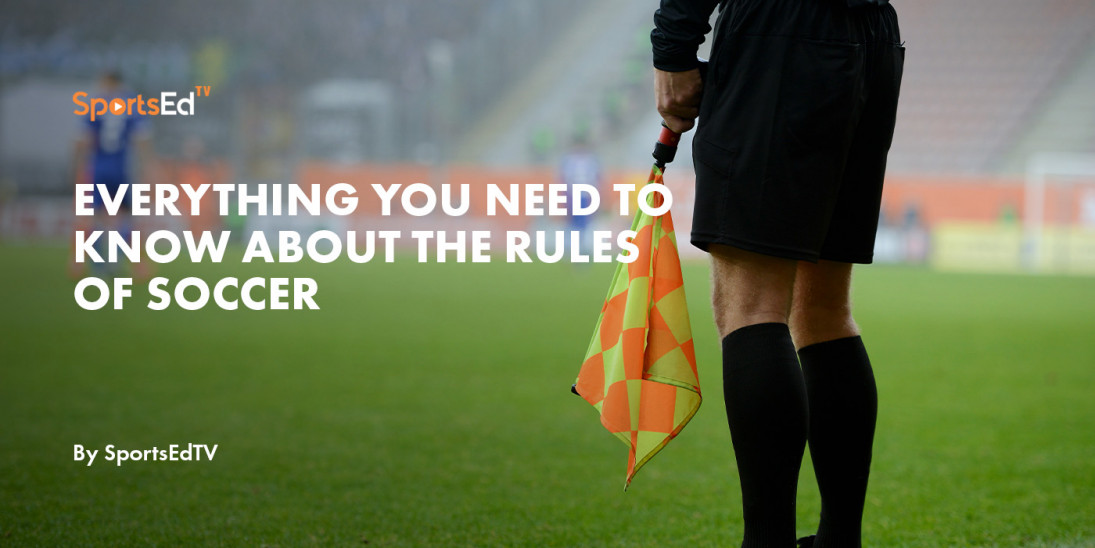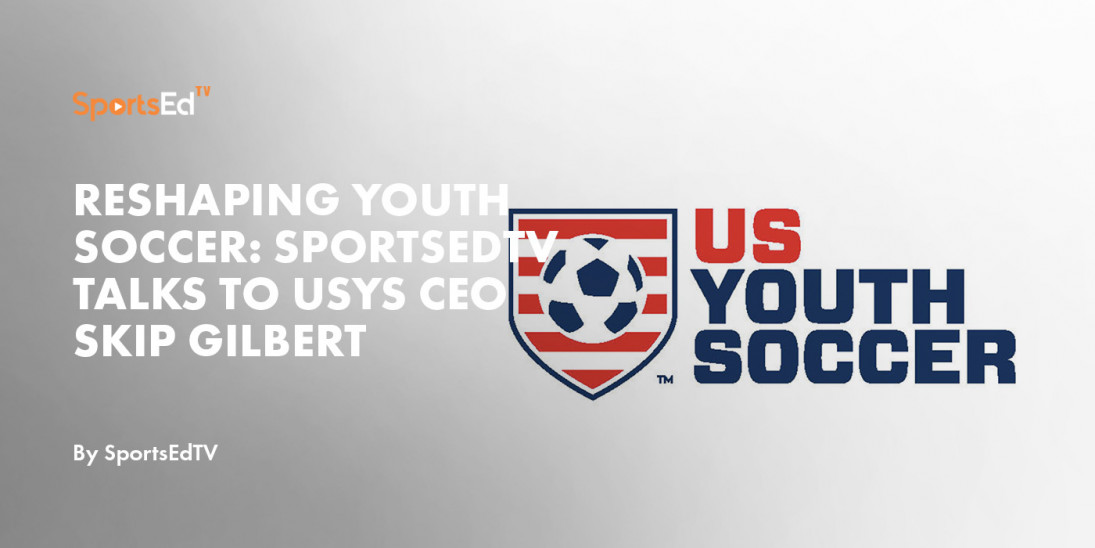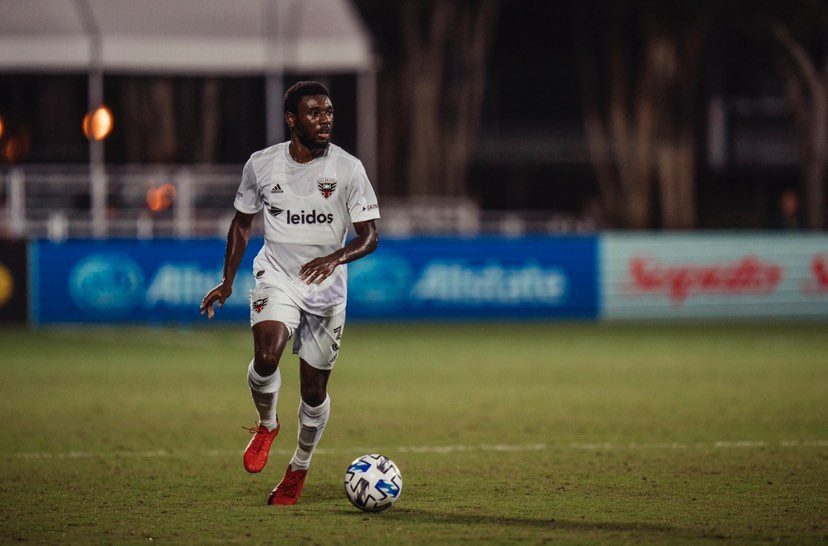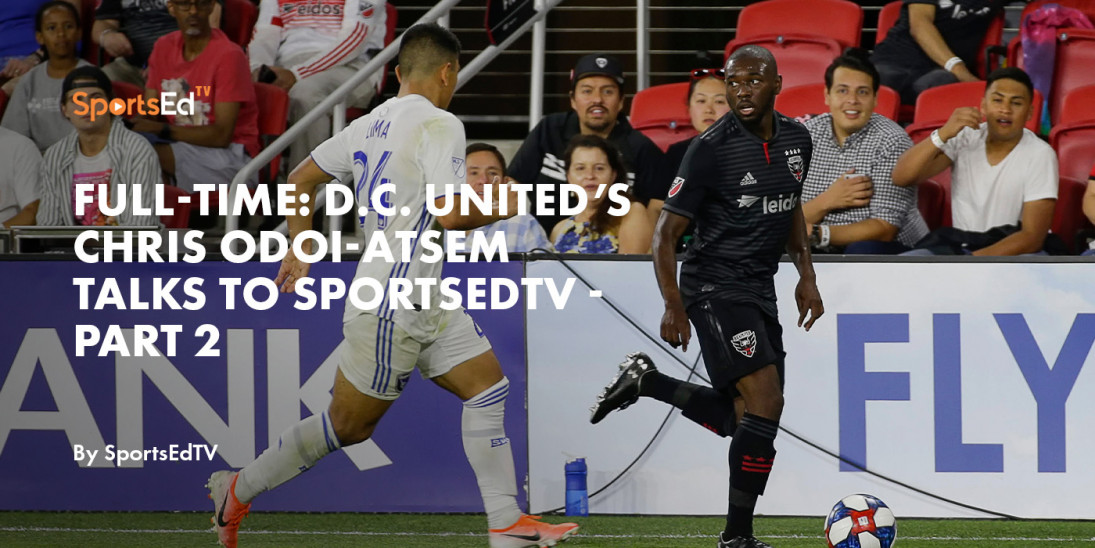Soccer
Welcome and thanks for visiting...

Everything You Need to Know About Football Positions
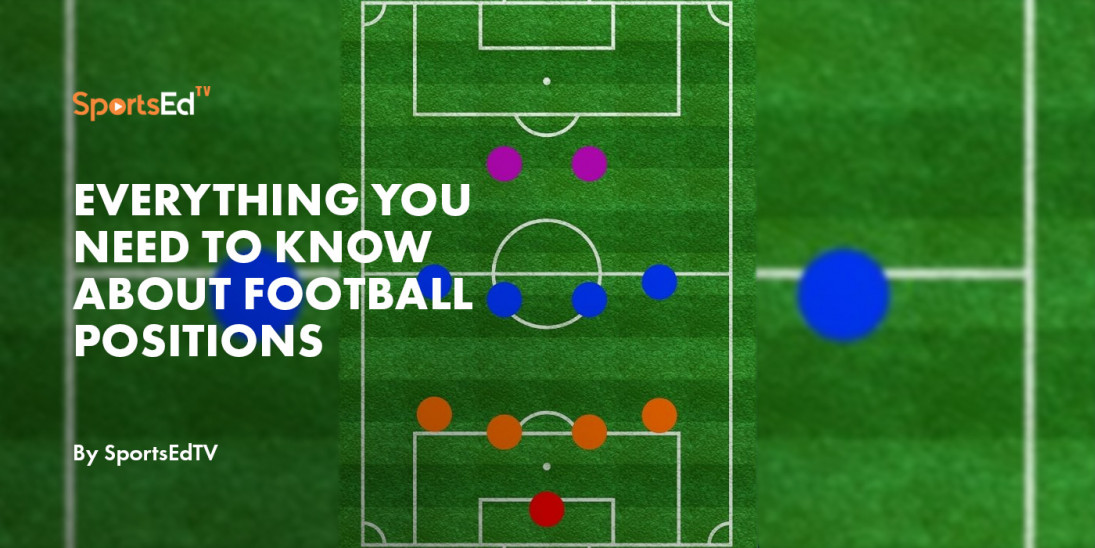
Take your game to the next level:
1. Sign up to join our Soccer community
2. Select Upgrade
3. Enter Promo Code: S973MdhZ
4. Access our 100s of free resources to help you improve
Introduction
Whether you want to improve as a player, a coach, or simply better enjoy watching football matches (and impress your friends with your football knowledge), understanding the positions behind the beautiful game is essential. On a basic level, football positions can be broken down into four categories:
- Goalkeepers
- Defenders
- Midfielders
- Forwards
This article will first cover the basics of how these positions are structured in a team (which is called a ‘formation’), and then the specifics of each position.
What Is A Football Formation?
Football teams always have 11 players on the field: 1 goalkeeper + 10 field players. A football formation refers to how a team’s 10 field players are structured for a match (and it can change at any point during the match). The formation is described as a few consecutive numbers (often 3) which generally refer to the number of defenders, midfielders, and forwards a team has on the field. These 3 numbers always add to 10 as they do not count the goalkeeper. One of the more common and straightforward formations is called a ‘4-4-2’. This means 4 defenders, 4 midfielders, and 2 forwards. The first number refers to defenders, the second to midfielders, and the third to forwards. Here is what that a 4-4-2 looks like for a team:
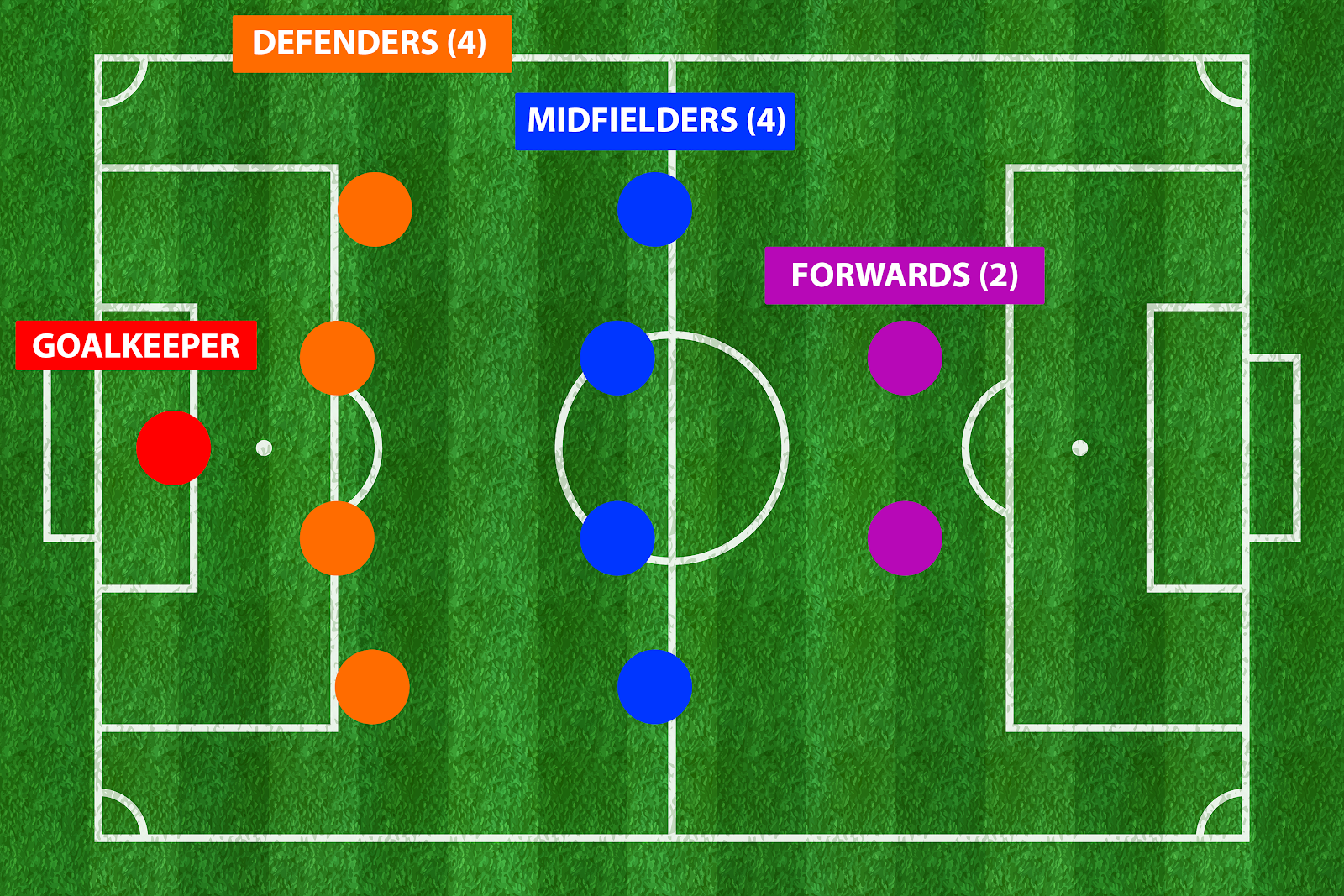
The formation a team will play is always announced before the match begins, however it will change throughout the game. Now that you’ve seen what a 4-4-2 looks like, let’s examine each of the positions that create this formation.
Goalkeepers
The goalkeeper is in some ways the most straightforward position, as it is always 1 player who generally remains around the team’s goal for the whole match. They can use their hands within the 18 yard box, which is shown here in highlighted in red:
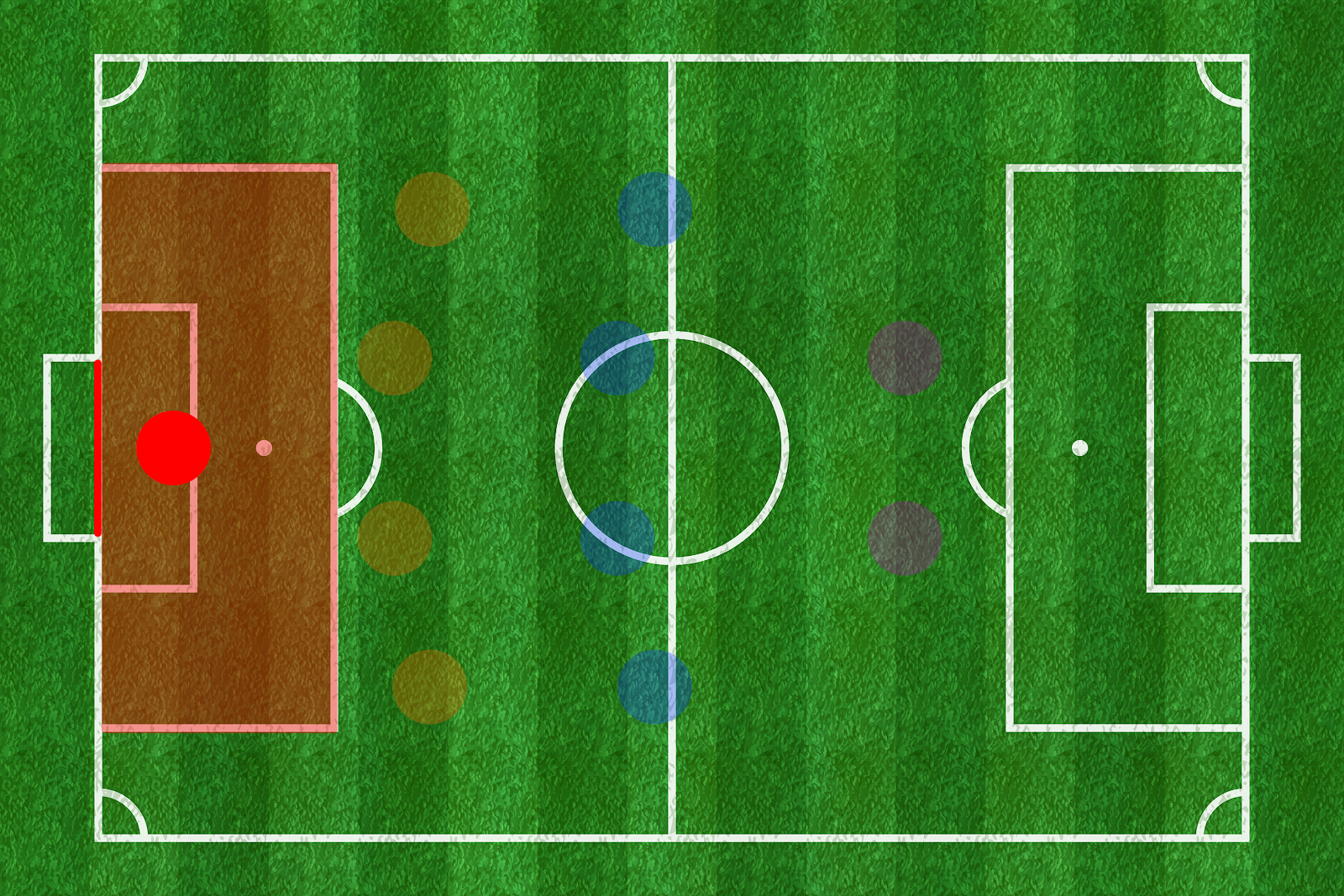
The goalie can use any part of their body within this 18-yard box, and is allowed to hold the ball in their hands for up to 6 seconds within this area. Outside of that box they cannot use their hands and are held to the same rules as the field players. Furthermore, if a teammate passes them the ball they cannot receive it with their hands even if they are inside the 18-yard box. They will primarily use their hands to stop shots, intercept passes by the opponents, and collect a loose ball. The goalkeeper’s objective is to stop the ball from entering the goal behind them. A goal is counted when the whole ball crosses the line between the posts. This line, called the goal line, is shown in the picture above as a bright red line behind the goalkeeper.
When the goalie’s team has the ball far on the other side of the field, you might see the goalie standing outside this 18-yard box by a considerable distance. This is common because it allows them to be a passing option for teammates if they need to pass back, as well as allowing the goalkeeper to intercept any long passess the opposing team might play.
Defenders
The defenders, also called the back line, will usually be 4 players. Sometimes it will be 3, and sometimes 5, but we’ll focus on the most common scenario of 4 for this explanation. There are different types of defenders, but here we’ll examine the two most general: Center-Backs and Fullbacks. From left to right, they are referred to as the left back (LB), center back (CB), center back (CB), and right back (RB). The left and right back are known as the fullbacks. Here is what the defending football positions looks like in the 4-4-2 formation:
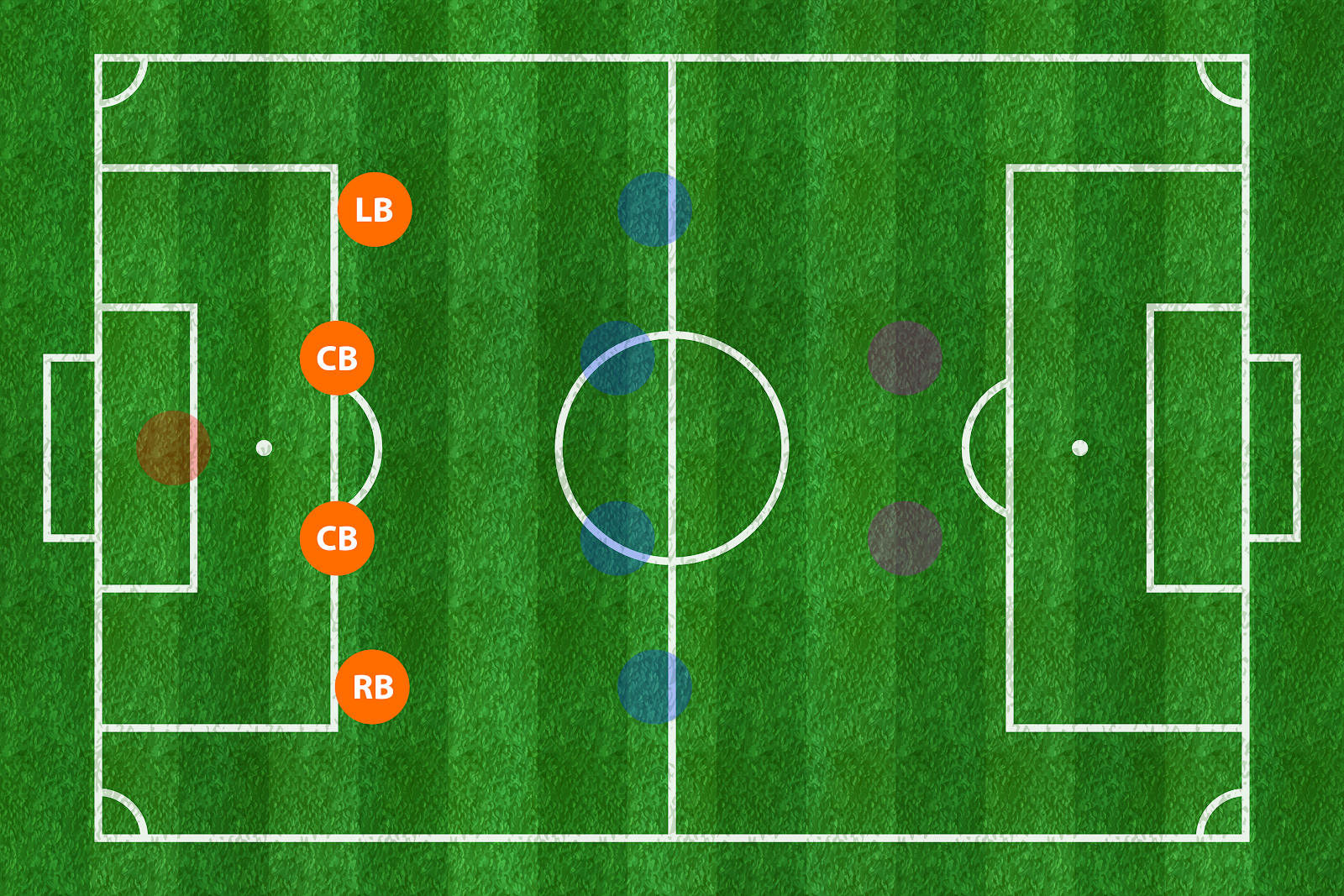
Center-Backs
The two center-backs are the middle of the defense, generally being tall and strong (although not always). Often the captain of the team is one of the center-backs. They are one of the positions more involved in organizing the rest of the team, as being central and behind they have a view of the full team at almost all times. They are constantly dealing with the forwards of the opposing team and must ensure that these opponents are always under pressure and never have enough space to receive the ball and play a dangerous pass or shoot. Below is a picture showing some of a centerback’s duties in defending the opposing forwards (shown as black circles), not letting them receive the ball close to goal and not letting them find space for a shot.
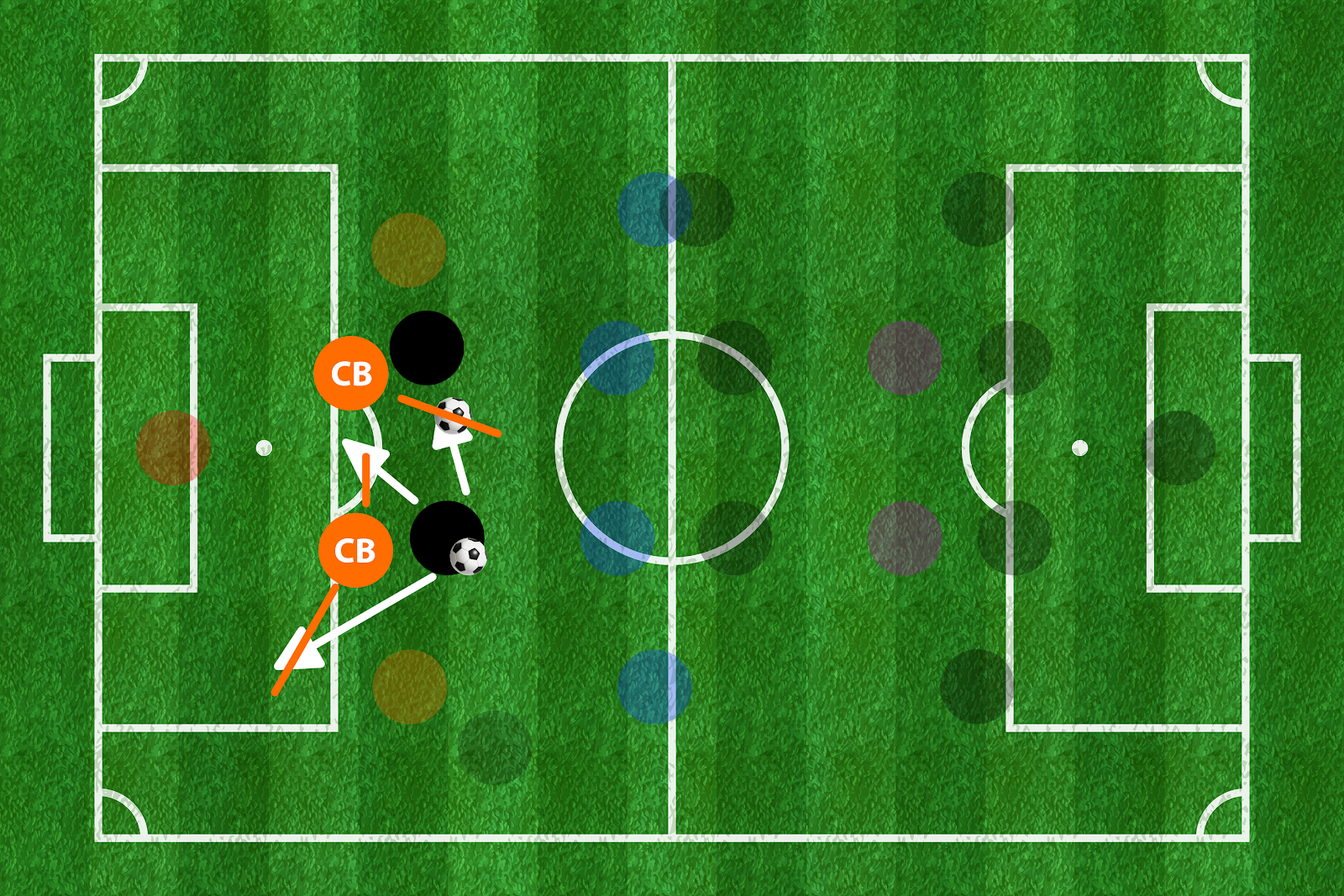
The white arrows show possible dribbling and passing paths for the forwards, and the orange lines show the responsilbities of the centerbacks to cut off the possible paths.
Depending on the team’s strategy, the center-backs might also be commonly involved in a practice called ‘playing out of the back’. When a team has the ball with their goalkeeper or defense, which happens frequently, they have two very general options:
- A long, usually in the air, pass up the field to a forward
- Play out of the back
Playing out of the back refers to a focus on playing on-the-ground passes with the aim of moving the ball from defense to midfield to forwards and into the opposing goal. This strategy generally results in a team having a larger percent of ball possession (time spent with the ball), however it can be risky as defenders might lose the ball trying to play out of the back if a pass is intercepted by an opposing forward, who will then have won the ball very close to goal.
Fullbacks
The fullbacks, or right and left backs, are the outside defenders. Not always, but often they are not quite as large as the center-backs and are faster with impressive stamina. They are also more involved in the attacking play than centerbacks, usually joining when their team is attacking on their side of the field (meaning a right back is likely to join an attack down the right side of the field). On defense, fullbacks are dealing with the opposing team’s wide midfielders or wingers (which we’ll explain soon), and are often in a 1v1 scenario where the opposing player has the ball and will try to dribble by them. This opposing player has 2 very general choices in this scenario, dribble outside and ‘down the line’ (meaning down the outside of the field) and cross the ball in, or dribble inside and look to create a scoring opportunity. The fullback must be ready to stop both of these making speed and quality 1v1 defending essential. Here is the situation the fullback often faces when defending, the black circles representing the other team:
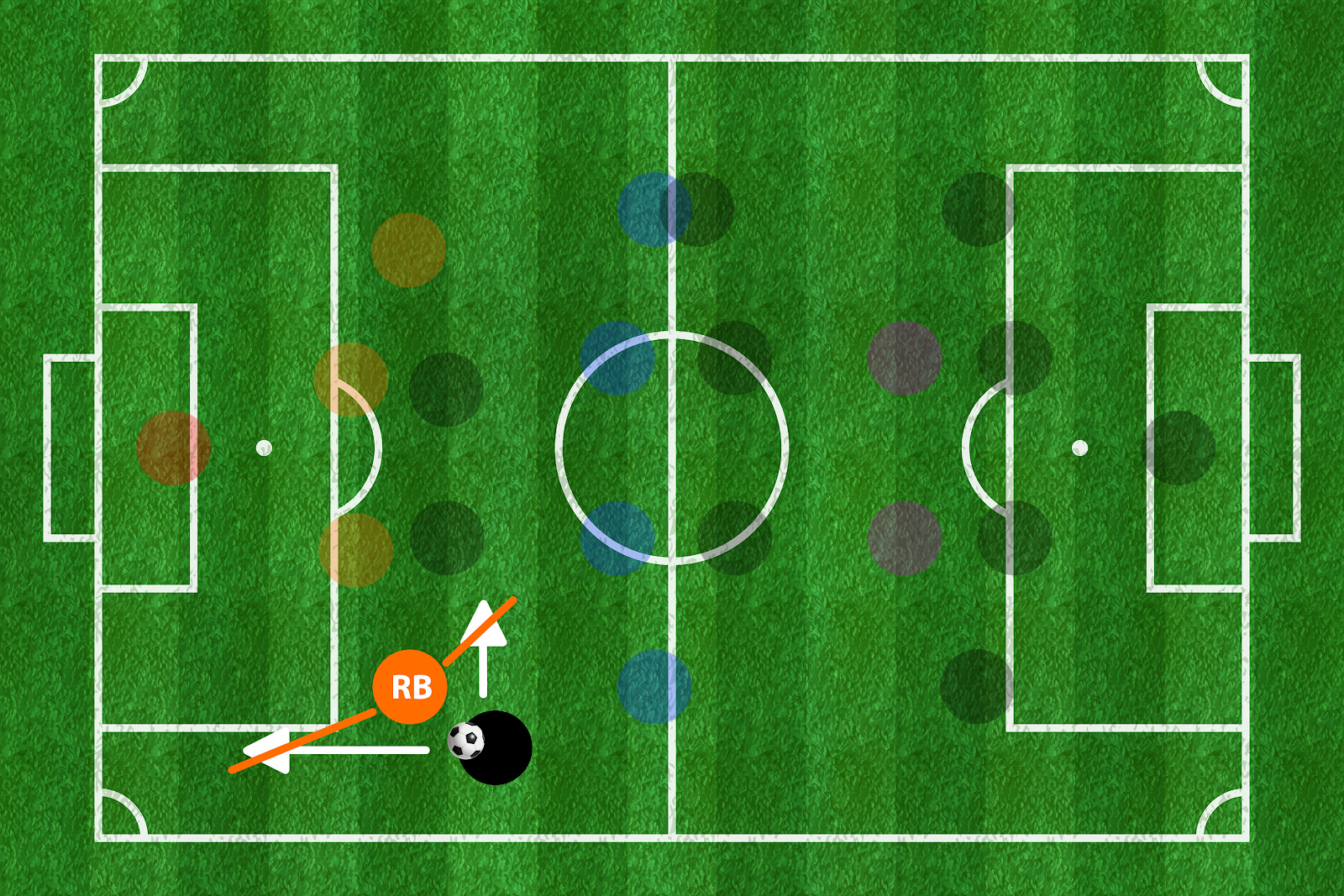
As seen, the right back needs to be ready to defend this opponent whether they dribble the ball inside the field or ‘down the line’.
Use code SETV10 and get 10% off all Fitlight products
Midfielders
Similar to defenders, midfielders can be broken into two very general categories: wide and center. Midfield formation varies, but in the 4-4-2 there are 2 central and 2 wide just like the defenders. Here are the midfield football positions in a 4-4-2:
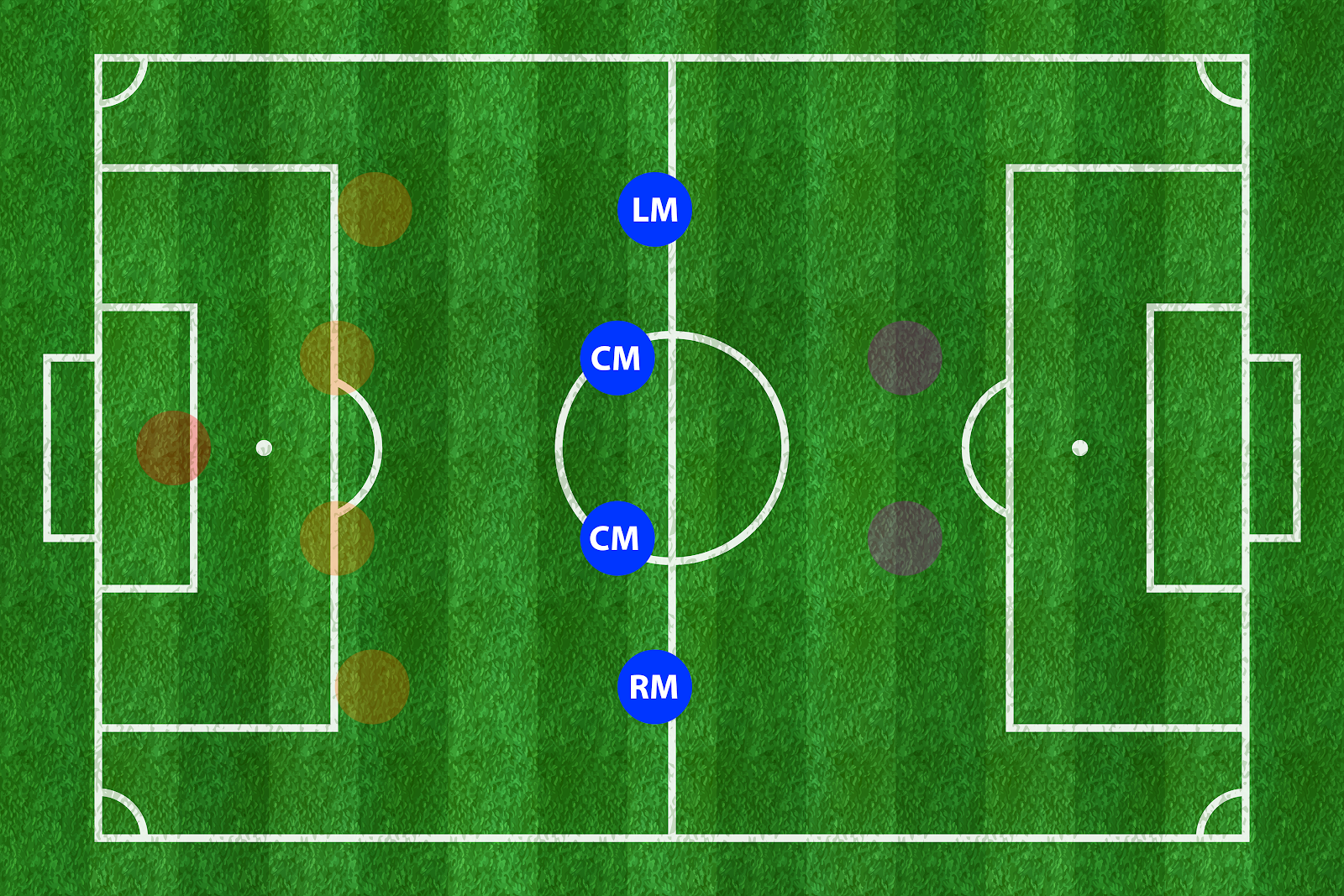
Central Midfielders
The role of the central midfielders is to help defend and steal the ball from the opposing team, keep possession through passing, move the ball from defense to attack, and ultimately help create scoring opportunities. They are involved in both defense and offense. Central midfielders are smart and technical players, able to read the game and predict the movements of both teammates and opponents and play accurate and quick passes. They must know what is happening around them at all times. Here are three options for a center midfielder with the ball (marked CM), from order top to bottom in the picture below:
- the other central midfielder drops back and is open to pass to
- the central midfielder with the ball dribbles around the opposing midfielder and plays a pass that puts their forward in on goal
- the central midfielder finds an open pass to the right midfielder.
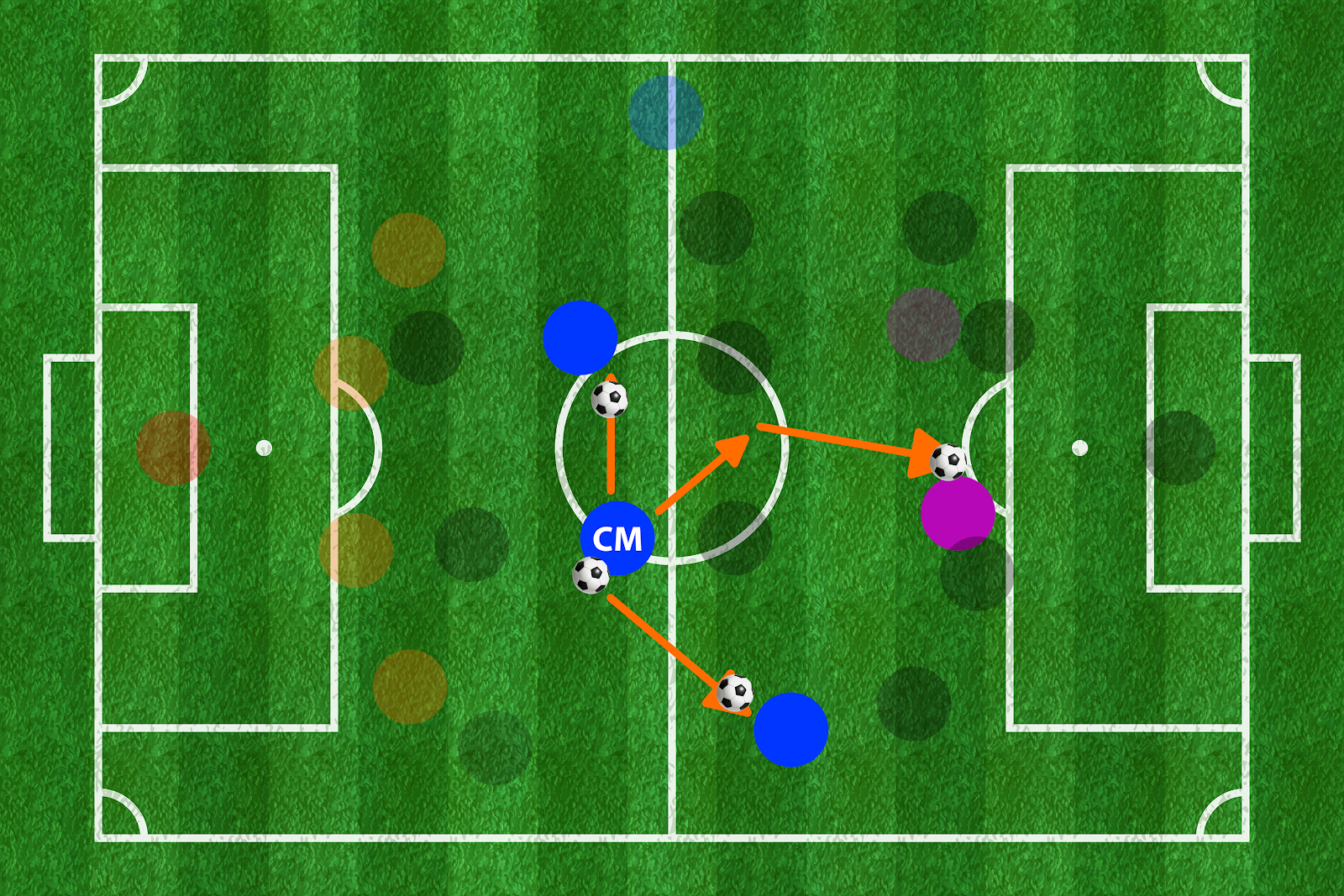
This shows three possibilities of what the center midfielder with the ball (marked CM) might do, depending on the positions of teammates and opposing players. Effective decision making is critical for central midfielders, as of many different possibilities they have to quickly determine which is the right pass to play.
Wide Midfielders
Teams generally play with either wide midfielders or wingers (we’ll cover wingers in the next section). Wide midfielders play along the left or right side of the field, and provide a passing outlet for their defenders and central midfielders. They will often try to either find a pass in to the forwards, or take the ball down the line and cross it in, both shown here:
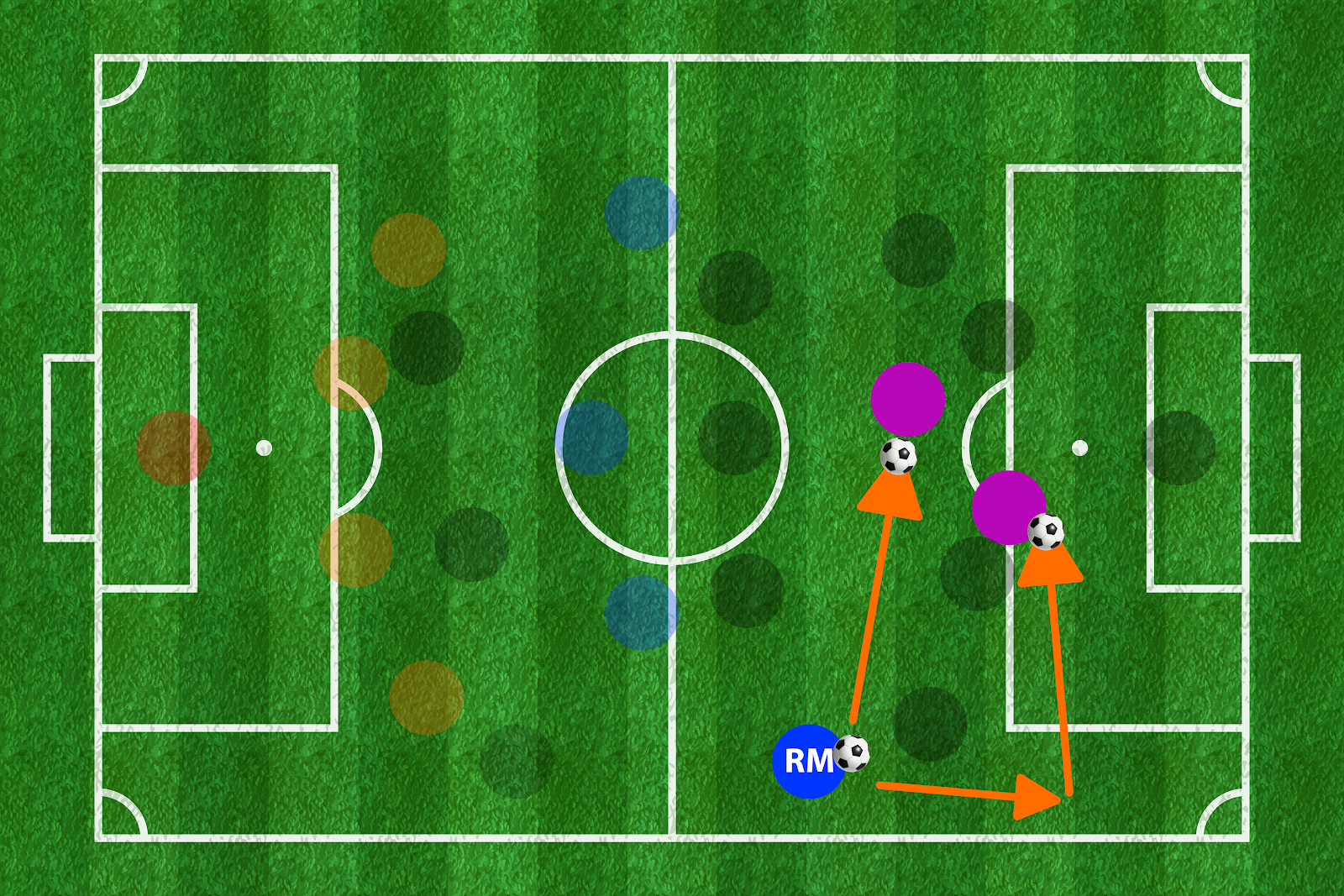
The right midfielder in this picture has two options, to pass to their center forward, or to dribble outside and cross the ball in for the center forwards to score off of.
However wide midfielders still have defensive duties, often needing to drop back and help defend against opposing fullbacks (the right and left defenders) who have come forward. The wide midfielder will also sometimes drop back to defense if one of their own team’s fullbacks has gotten far up and joined the attacking play.
Forwards
In a 4-4-2 there are 2 center forwards (also called strikers). Often 1 of them will play a little bit behind the other, but they might be in the same line as well or change back and forth throughout the game. Here is what they look like in the same line in a 4-4-2:
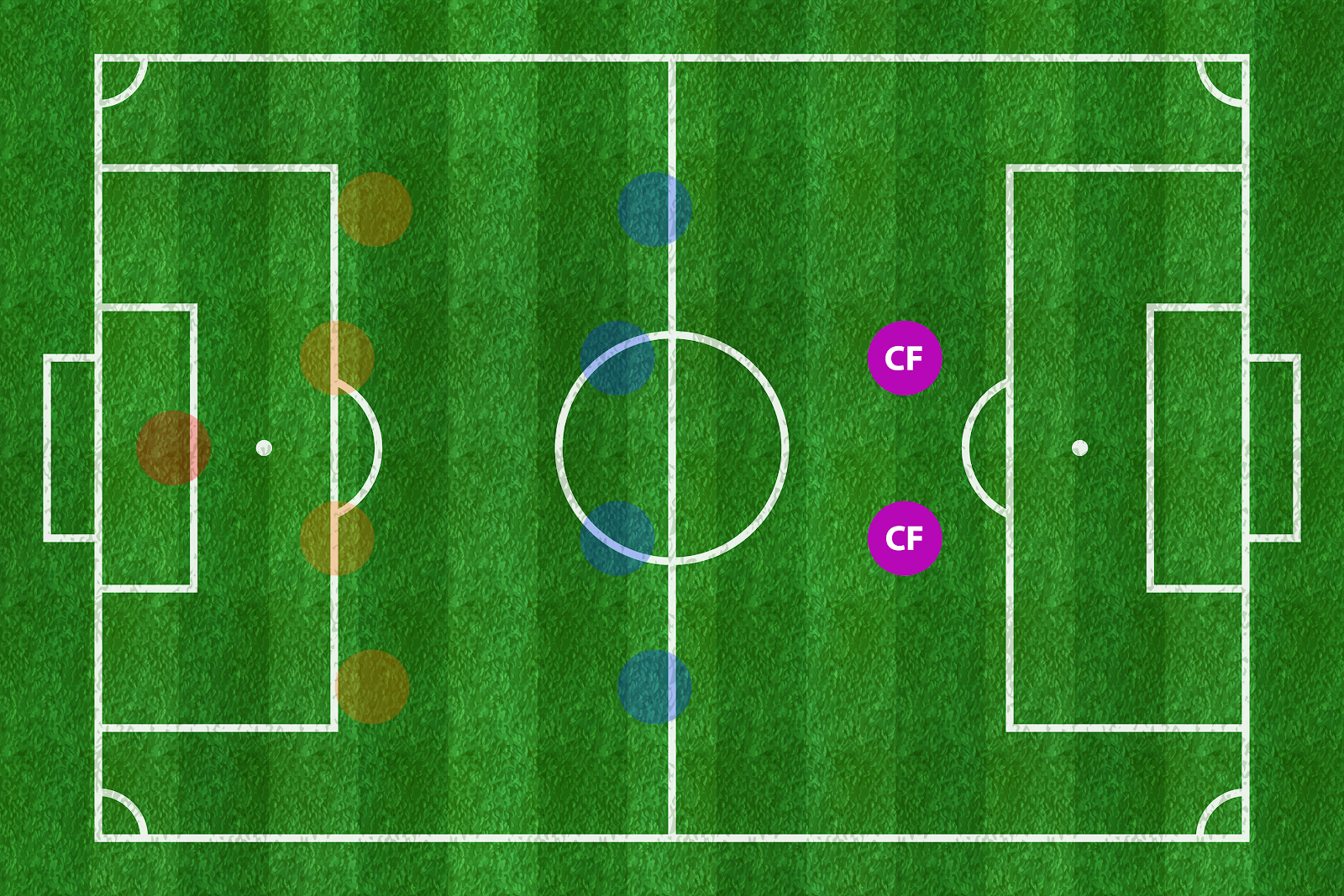
Centerforwards
The main job of center forwards in football is to score. They are always looking to get behind the opposing team’s center backs and in a 1v1 situation with the goalie. They will also occasionally drop back a little to help their team with passing when needed (though usually only one at a time will do this). Center forwards vary in playstyle and physical attributes, but they are always very effective finishers (heading, scoring off a cross, etc.). Here is a typical center forward run and finish that often results in a goal. The arrow behind the center forward shows their run to escape the opposing center-backs and meet the cross from their wide midfielder.
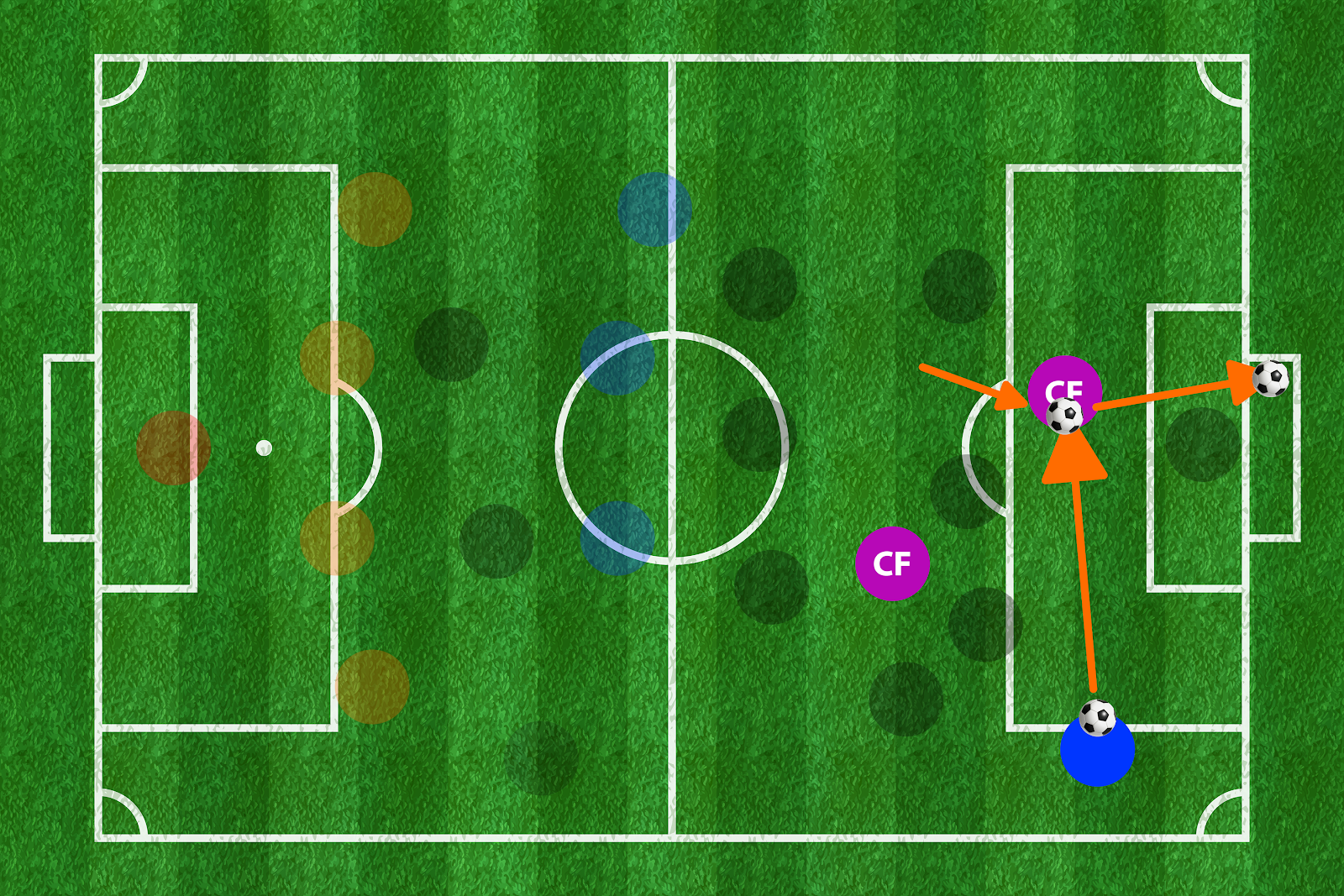
In this scenario, the wide midfielder crossed the ball in to meet the center forward’s run who scored with one touch. Scoring with one touch means that as the ball approached the forward they immediately shot it towards goal with their first touch, rather than taking a touch to control the ball first. Usually a forward in this situation won’t have time to take two touches (one to control one to shoot), so it’s important they are effective at shooting with their first touch (which can be difficult depending on how fast the incoming pass is and how fast they are running).
Wingers and a 4-3-3
We have now covered all of the football positions in a 4-4-2, however there is another type of forward commonly used that doesn’t appear in a 4-4-2. This type of forward is a winger, which you can think of as a wide midfielder that plays further up the field, or a forward that plays far to the left or right side. The most common football formation involving wingers is a 4-3-3. Here is what that looks like, with the wingers labeled (LW for left wing, RW for right wing).
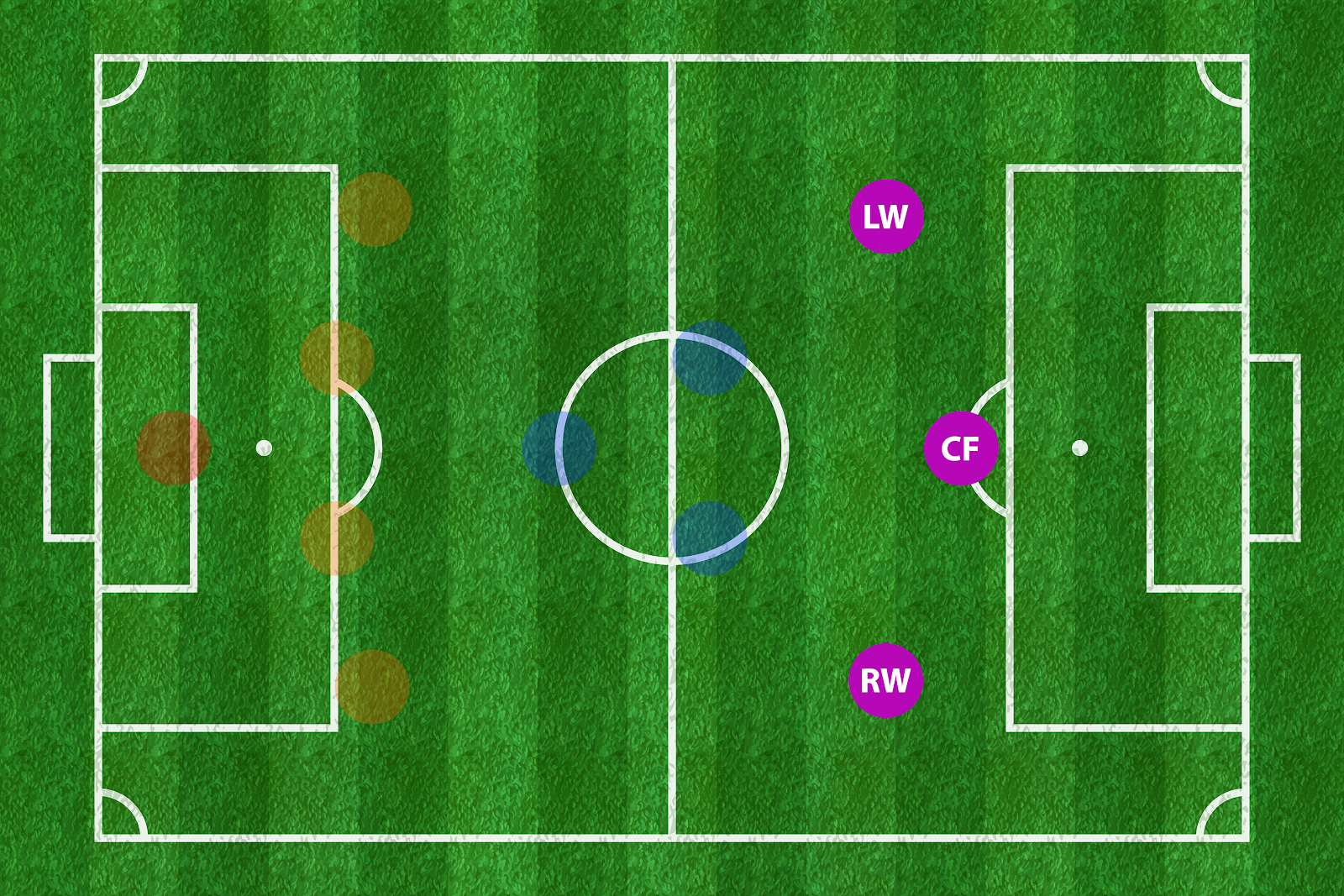
As you can see, in a 4-3-3 there are 3 central midfielders, 2 wingers, and 1 center forward. The midfielders are now structured differently, with 1 being more defending and 2 being more attacking, and wingers are used instead of wide midfielders. Wingers are effectively a more attacking version of the wide midfielders. Wingers are often fast players and generally very skilled at dribbling in 1v1 scenarios (often against the opposing fullback, as we covered before in the fullback section). They will constantly look to either dribble down the line and cross the ball in to their forwards, or cut inside and find a shot on goal, both shown here:
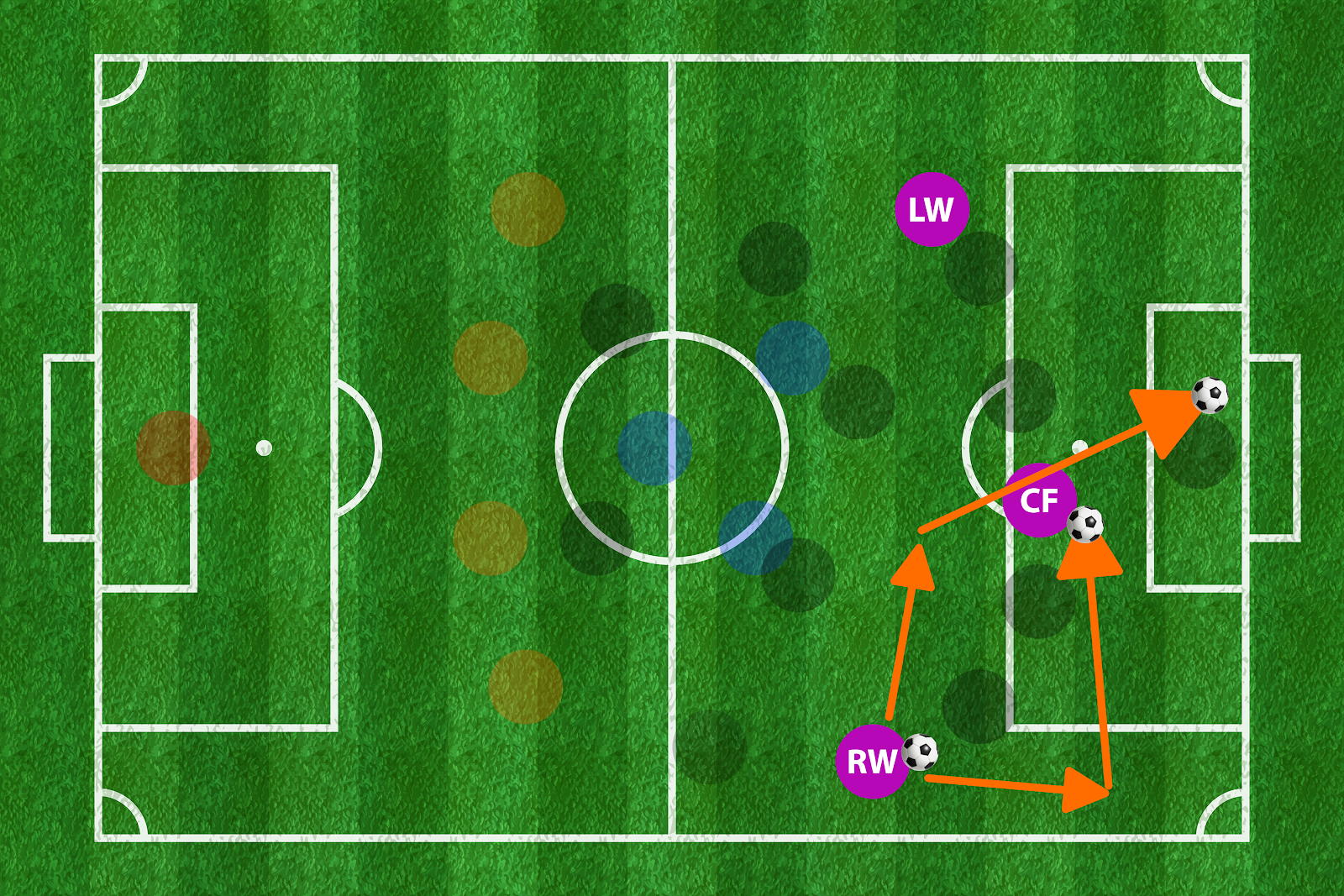
The first option shows the winger dribbling the ball inside and finding an opening for a shot. The second shows the winger taking the ball ‘down the line’ (which means outside the field, as the player is staying close to the line) and crossing the ball in. You might notice that this crossing into the center forward is the same play that we highlighted when describing the center forward. This cross and finish is a very common way for goals to be scored.
Conclusion
That covers the basics of formations, goalkeepers, central defenders, fullbacks, central midfielders, wide midfielders, center forwards, and wingers. Watching professional games is a great way to further understand the various football positions and how they move and relate to eachother. The games get more entertaining to watch the more you understand about the football positions as there are so many intricate relationships and patterns that play out every match between these different positions. There’s a reason it’s called the beautiful game!
Follow SportsEdTV Football on Facebook and Instagram to stay up-to-date with the latest free pro-level football education


